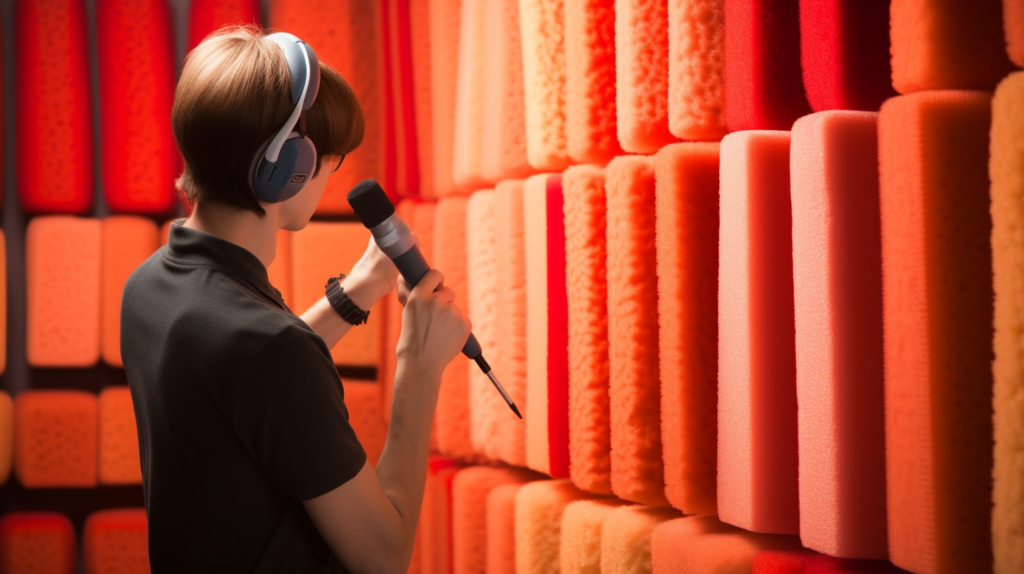But after installing it, you still hear the noisy traffic and your neighbor’s loud TV. What went wrong?
You’ve just moved into your dream apartment, but there’s one problem: it’s too noisy. So, you decide to invest in acoustic foam, thinking it will soundproof your space.
The truth is, while acoustic foam is an excellent material for reducing certain types of noise, it’s not a one-size-fits-all solution for soundproofing a room.
Many people misunderstand its capabilities, thinking it can entirely block out sound, which is far from the truth.
So, if acoustic foam isn’t the silver bullet for soundproofing, what is it good for? And what alternatives should you consider for more effective sound isolation?
Let’s dive into the fascinating world of acoustic materials to find out.
What’s the Difference Between Soundproofing and Noise Reduction with Acoustic Foam?

When people think of creating a quieter space, acoustic foam often comes to mind.
The popular perception is that this material can “soundproof” an area, making it completely devoid of unwanted sound. Unfortunately, this is a misunderstanding that needs to be corrected.
Acoustic foam is a highly effective material for certain types of noise control, but it’s crucial to differentiate between soundproofing and noise reduction.
“Soundproofing” is a term that implies the complete isolation of sound. It means preventing any sound from either entering or leaving a given space. This is not what acoustic foam does.
“Noise reduction,” on the other hand, involves decreasing the sound pressure with respect to a specified sound source and receptor.
In simpler terms, noise reduction materials like acoustic foam can lessen the impact of the noise, but they can’t eliminate it entirely.
Acoustic foam is engineered to absorb sound waves, particularly those at higher frequencies, but it doesn’t block sound.
Understanding these distinctions is not just a matter of semantics. It has practical implications for anyone looking to address noise issues.
If you install acoustic foam thinking it will “soundproof” your room, you’re likely to be disappointed. You’ll reduce some noises, but you won’t achieve complete silence.
How Does Acoustic Foam Do It’s Job Absorbing Sound?

The idea that foam—a soft, spongy material—can have any impact on noise might seem counterintuitive at first. However, the effectiveness of acoustic foam comes down to two key factors: its material properties and its design. Let’s dive into the science behind it.
Firstly, acoustic foam is primarily made from polyurethane, a type of polymer that can be engineered to have an open-cell structure. This structure captures air molecules, which in turn disrupts the pathway of sound waves traveling through the air. This causes the sound waves to lose energy, reducing their amplitude and making the sound less audible.
Additionally, the shape and thickness of acoustic foam can significantly affect its ability to absorb sound. You’ll find acoustic foam in various shapes like pyramids, wedges, and egg-crate designs, each serving a specific purpose. Pyramid-shaped foam is particularly effective at absorbing high-frequency sounds, while wedge-shaped foam can absorb medium to high-frequency sounds.
Yet, it’s crucial to remember that while acoustic foam can lessen the impact of certain sounds, it’s not a one-size-fits-all solution for all your noise issues. In other words, while it can help make a room quieter, it can’t make it completely silent.
Can Acoustic Foam Reduce High-Frequency Noise?

So, if acoustic foam is not for soundproofing, what is it good for? The answer lies in its proficiency at reducing high-frequency noise.
High-frequency noise is usually defined as sound that ranges from about 2,000 to 20,000 Hz.
This encompasses a variety of sounds that you encounter in everyday life—human speech, music, and even the high-pitched beep of an electronic device.
The effectiveness of acoustic foam in reducing high-frequency noise makes it a popular choice for specific settings.
Recording studios, for instance, benefit immensely from the use of acoustic foam. In such environments, even the slightest echo or reverberation can ruin an audio recording.
Acoustic foam helps by absorbing these sounds, thereby improving the clarity and quality of the recorded audio.
Home theaters are another area where acoustic foam can be quite beneficial. When watching a movie or listening to music, you want the audio to be as clear as possible.
Acoustic foam can absorb the echoes and reverberations that would otherwise bounce off the walls and ceilings, muddying the sound quality.
However, it’s important to note that the effectiveness of acoustic foam decreases as the frequency of the noise decreases.
In simpler terms, don’t expect acoustic foam to block out low-frequency sounds like the rumbling of a truck engine or the bass in music. For these types of sounds, other solutions would be more effective.
Why Can’t Acoustic Foam Soundproof a Room?

You may still be wondering why acoustic foam, despite its effectiveness at reducing high-frequency noise, falls short of soundproofing a room.
The reason is in its physical composition. Acoustic foam is designed to absorb rather than block sound. It’s a distinction that may sound trivial, but in the world of acoustics, it’s crucial.
To block sound effectively, a material needs to have certain properties like density and mass. This is because sound waves are essentially vibrations that travel through a medium, like air or a wall.
To stop these vibrations, you need a material that can act as a barrier. Acoustic foam doesn’t have the density or mass to serve as such a barrier.
This is why denser materials like mineral wool or fiberglass are often recommended for soundproofing projects.
These materials have the mass needed to block sound waves and can be used in construction to create sound barriers.
However, even these materials are not 100% effective, especially when compared to specialized soundproofing solutions.
What Are the Alternatives for Soundproofing a Room?

If acoustic foam falls short of fully soundproofing a room, what options do we have? It’s a critical question, especially for those dealing with persistent noise issues that go beyond mere annoyance.
Fortunately, the world of acoustics offers a range of solutions tailored for more effective soundproofing.
One such option is specialized soundproofing foam. Unlike acoustic foam, which is designed for noise reduction, soundproofing foam is engineered to block sound.
It’s usually made from denser materials and is often installed within walls and ceilings to provide a comprehensive soundproofing solution.
This foam doesn’t just absorb sound but also blocks it, making it a more effective choice for those looking to fully soundproof a space.
Another product worth considering is soundproofing panels by Burton Acoustix. These are specifically designed to tackle airborne noises and, to some extent, structure-borne noises as well.
Airborne noise includes sounds like conversations, TV audio, and music, while structure-borne noise includes sounds like footsteps and furniture moving.
These panels are usually installed on walls and ceilings and offer a more specialized approach to soundproofing.
Then there are polyester acoustic panels. While they can’t provide full soundproofing, they are remarkably effective at reducing noise. These panels are often made from recycled materials, making them an eco-friendly choice. They are commonly used in commercial settings such as offices, conference rooms, and even in educational institutions. Their versatility and the variety of designs available make them a popular choice for both aesthetic appeal and acoustic treatment.
What Should You Know Before Buying Acoustic Foam?

Investing in acoustic foam or any other soundproofing material is not something to be done lightly. There are several factors to consider to ensure that you’re making an informed decision.
One of the most common concerns people have is regarding the flammability of acoustic foam. Is it safe to use in any setting?
Many high-quality acoustic foams are treated with fire-retardant chemicals, making them safer for use in various environments.
However, it’s always advisable to check the specifications and safety ratings before making a purchase.
This is especially crucial for settings like recording studios, where electrical equipment is in use, increasing the risk of fire.
Another frequently asked question is whether acoustic foam can be painted.
The short answer is yes, but with caveats. Painting can alter the foam’s cellular structure, potentially affecting its sound-absorbing capabilities.
If you’re considering adding a splash of color to your foam, consult the manufacturer’s guidelines or speak with an expert to understand the implications.
Conclusion
Navigating the world of acoustic materials can be a complex endeavor, filled with technical terms and varied solutions.
However, the fundamental takeaway is clear: acoustic foam is a powerful tool for reducing high-frequency noise but is not a catch-all solution for soundproofing a room.
Understanding this distinction can save you both time and money, steering you toward the most effective solution for your specific needs.
If you’re dealing with issues like echoes, human speech, or high-pitched sounds, acoustic foam can offer significant relief.
But if your challenges involve low-frequency noises or the need for complete sound isolation, you’ll have to explore denser, more specialized materials like soundproofing foam or soundproofing panels.
And let’s not overlook the versatility and aesthetic appeal of polyester acoustic panels, which offer both noise reduction and design flexibility.
Safety considerations, such as fire-retardant properties, and customization options like painting, are additional factors to weigh before making a purchase.
Always consult manufacturer guidelines and consider seeking expert advice to tailor your acoustic solution precisely to your environment.
In the end, the key to a successful acoustic project lies in research and understanding. Know what you’re up against, what solutions are available, and what each can or cannot achieve.
Armed with this knowledge, you’re well on your way to creating a quieter, more peaceful space tailored to your needs.
